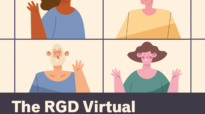A new section on cultural appropriation added to the RGD's Code of Ethics

The RGD introduces Responsibilities to Cultures section to the Code of Ethics
Now a unified document with DesCan and SDGQ, the Code of Ethics provides a framework of rules that Members must follow along with recommended best practices. Current sections in the Code pertain to working with clients, responsibilities to society and the environment, competitions and fees, intellectual property and more.
Members of the RGD’s Diversity and Inclusion Committee have been working on the new section since July. Having been approved by the RGD’s Board of Directors, it was presented and ratified at the Annual General Meeting on Saturday (April 20).

“Adding a section about cultural appropriation to the Code of Ethics was long overdue. We’ve received questions and concerns from Members over the years about cultural appropriation in design and having these rules and best practices in place will provide some much-needed guidance and support. Our hope is that this new section ensures that RGD Members are able to contribute to the diverse world of design while also safeguarding the rights and cultures of Indigenous peoples and other marginalized groups.”
Nicola Hamilton RGD
The Responsibilities to Cultures section provides guidelines to designers to uphold ethical practices when engaging with diverse cultural heritage, traditional knowledge and faith-based cultural expressions. It reflects an awareness within the design community of the importance of respecting and honouring the ownership and intellectual property rights of various cultures and identities, including Indigenous peoples.

“We strive to be an industry that's ethically responsible not only to our society and the environment, but also to cultures and identities that predate and surround us. This new section emphasizes refraining from appropriating cultures outside our own and encourages exploration beyond stereotypes to foster informed, respectful and culturally-sensitive creative expressions. I’m excited to see richer and more in-depth projects, as well as exciting collaborations, emerge from these new best practices.”
Xandr Sutjiadi RGD
Some key elements encapsulated within this new section include:
- Respecting and honouring the cultural heritage and traditional knowledge of other cultures, emphasizing the significance of acknowledging and valuing diverse cultural contributions.
- Seeking prior consent when incorporating design elements from other cultures. This involves engaging with interested parties, cultural custodians and knowledge keepers to ensure a respectful and collaborative approach.
- Ensuring that Indigenous peoples and other cultures share in the benefits of their cultural heritage, especially in commercial applications. This includes financial benefits and proper attribution of cultural origins.
- Creating an inclusive space, free of racism and discrimination and recognizing the importance of diverse worldviews and lived experiences. This involves considering power imbalances and fostering an environment where all individuals feel safe and valued.
- The new section also outlines best practices, such as establishing a diversity of review process to prevent the spread of cultural stereotypes in creative work and educating clients about the ethical considerations surrounding cultural appropriation.
Mentioned in this article
Tags
Related Articles


Giulia Bonforte RGD, Donna Graffi-Smith RGD, Meggan van Harten RGD, Iffat Jokhio RGD, Karen Ng-Hem RGD, Kathleen Scott RGD














